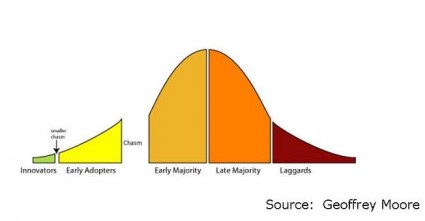When I first read Geoffery Moore’s Crossing the Chasm in the early 1990s, I was amazed at how well the author, then a partner at Regis McKenna, Inc., nailed what worked and what didn’t work in technology marketing. What is even more amazing to me is that the book is still highly relevant for high tech marketing today; in fact, I believe it was a harbinger of today’s “new” buying paradigm that is made possible through social networking.
 At the time I read the book, I was Director of Marketing at a B2B application software company, and the concepts of early technology adopters versus “majority” buyers, the importance of choosing the right set of customers upon whose testimonials you can “cross the chasm” to the mass market, the pain of attaching your technology to the wrong distribution channel to cross over, and the fact that technology buyers weighed peer recommendations most heavily in their decisions were all things I had been experiencing.
At the time I read the book, I was Director of Marketing at a B2B application software company, and the concepts of early technology adopters versus “majority” buyers, the importance of choosing the right set of customers upon whose testimonials you can “cross the chasm” to the mass market, the pain of attaching your technology to the wrong distribution channel to cross over, and the fact that technology buyers weighed peer recommendations most heavily in their decisions were all things I had been experiencing.
Back then, we didn’t have CTOs (Chief Technology Officers) – we had DP (Data Processing) Managers, then IS (Information System) Managers. When their company needed a mission-critical application, they turned to their IS buddy across town or in their industry, to find out what worked and what didn’t.
We made some mistakes, one of which was choosing to tie our coattails to Informix over ORACLE for our database technology, because we believed the technology was superior. Choosing the better technology would make our product superior, right? Wrong! When we hit the streets to cross the chasm/sell our software, IT Managers had one thing on their mind: ORACLE. The reasons? ORACLE’s superior marketing and positioning of its portability across platforms.
We also did some things right, including creating peer-review marketing campaigns with ads that included industry leader testimonials, and (gasp! – pre-YouTube!) videos of customer testimonials. We were very successful with these campaigns, and Moore validated the reason in his book:
“Numerous studies have shown that in the high-tech buying process, word of mouth is the number one source of information buyers reference, both at the beginning of the sales cycle, to establish their ‘long lists,’ and at the end, when they are paring down their short ones.”
Page 69, “The D-Day Analogy,” Crossing the Chasm
Now that technology has permeated every business and almost every individual’s life, social networking allows us to quite easily follow, and take our buying cues from, our peers and industry thought leaders. I believe this is a sign of disruptive technology (Internet, Web 2.0) catching up with and allowing the high tech buying paradigm from over 20 years ago to be adopted by the mass market.
Image by cambodia4kidsorg on Flickr, CC BY 2.0









{ 2 trackbacks }
{ 2 comments… read them below or add one }
Jennifer, excellent point! Geoff is so timeless because he focused on the constant in the disruptive tech equation: how groups of B2B execs vet and adopt new things. It hasn’t changed much over time, beginning with farmers/seeds, moving through cars, telephones, telegraph, tech and now relationships (social networks). Also it’s not often mentioned, but Geoff’s stuff is more prescient for B2B because of the higher ticket price and business risk. Consumers always adopt first if the disruption has a low entry price where they can experiment. I recognized this several years ago and developed the Social Network Roadmap way ahead of the market. The disruption changes over time but decision making not so much. SNs just digitize, automate and speed the process (which is HUGE). Thanks for your personal experiences, too!
Chris, great points. I agree regarding higher ticket price with higher business risk requiring peer testimonials. In the ERP software industry, we had high ticket prices AND mission critical functions, making the peer testimonial even more important.